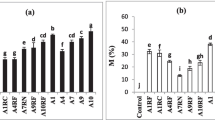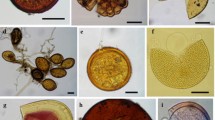Abstract
Some acidic red soils in hilly regions of subtropical China were degraded as a result of slope erosion following the removal of natural vegetation, primarily for fuel. Revegetation is important for the recovery of the degraded ecosystem, but plant growth is limited by the low fertility of eroded sites. One factor contributing to the low fertility may be low inoculum density of arbuscular mycorrhizal (AM) fungi. Compared to red soils under natural vegetation or in agricultural production, substrates on eroded sites had significantly lower AM fungal propagule densities. Thus, the management and/or application of AM fungi may increase plant growth and accelerate revegetation. Thirteen species of AM fungi were identified in red soils by spore morphology. Scutellospora heterogama, Glomus manihotis, Gigaspora margarita, Glomus aggregatum and Acaulospora laevis were among the most common according to spore numbers. Pot cultures were used to isolate and propagate 14 isolates of AM fungi indigenous to red soil. The effectiveness of each fungus in promotion of growth of mungbean was evaluated in red soil. For comparison, three isolates from northern China, known to be highly effective in neutral soils, and two isolates from Australia, known to be from acidic soil were used. Effectiveness was positively related to root infection (r 2 = 0.601). For two of these isolates, Glomus caledonium (isolated from northern China) and Glomus manihotis (an isolate indigenous to red soil), the applied P concentration giving the highest infection and response to infection was approximately 17.5 mg P kg−1 soil. In field experiments in which this concentration of P was applied, the five most effective isolates were tested on mungbean. The Glomus caledonium isolate from northern China was the most effective, followed by the indigenous Glomus manihotis isolate. The Glomus caledonium isolate was also shown to be effective on Lespedeza formosa, which is commonly used in revegetation efforts. We conclude that inoculation of plants with selected isolates of AM fungi may aid in revegetation efforts on eroded red soils in subtropical China.
Similar content being viewed by others
References
Abbott L K and Robson A D 1981 Infectivity and effectiveness of vesicular arbuscular mycorrhizal fungi: effect of inoculum type. Aust. J. Agric. Res. 32, 631–639.
Abbott L K and Robson A D 1991 Factors influencing the occurrence of vesicular-arbuscular mycorrhizas. Agric. Ecosyst. Environ. 35, 121–150.
Abbott L K, Robson A D and Gazey C 1992 Selection of inoculant vesicular-arbuscular mycorrhizal fungi. In: Methods in Microbiology, Vol. 24. Academic Press, New York.
Amijee F, Tinker P B and Stribley D P 1989 The development of endomycorrhizal root system VII. A detailed study of effect of soil phosphorus on colonization. New Phytol. 111, 435–446.
Bartolome-Esteban H and Schenck N C 1994 Spore germination and hyphal growth of arbuscular mycorrhizal fungi in relation to soil aluminium. Mycologia 86, 217–226.
Bray R H and Kurtz LT 1945 Determination of total, organic, and available forms of phosphorus in soils. Soil Sci. 59, 39–45.
Bremner J M 1960 Determination of nitrogen in soil by the Kjeldahl method. J. Agric. Sci. 55, 11–33.
Brundrett M, Melville L and Peterson L 1994 Practical methods in mycorrhizal research. Mycologue Publications.
Carrillo-Garcia A, Leon de la Luz J L, Bashan Y and Bethlenfalvay G J 1999 Nurseplants, mycorrhizae, and plant establishment in a disturbed area of Sonoran desert. Restoration Ecology 7, 321–335.
Cuenca G, De Andrade Z and Escalante G 1998 Arbuscular mycorrhizae in the rehabilitation of fragile degraded tropical lands. Biol. Fertil. Soils 26, 107–111.
Dodd J C and Thomson B D 1994 The screening and selection of inoculant arbuscular-mycorrhizal and ectomycorrhizal fungi. Pages 149-158 In A. D.Robson, L. K. Abbott and N. Malajczuk, editors. Management of Mycorrhizas in Agricultural, Horticulture and Forestry. Kluwer Academic Publishers.
Dodd J C, Arias I, Koomen I and Hayman D S 1990a The management of populations of vesicular-arbuscular mycorrhizal fungi in acid-infertile soils of a savannah ecosystem I. The effect of precropping and inoculation with VAM fungi on plant growth and nutrition in the field. Plant Soil 122, 229–240.
Dodd J C, Arias I, Koomen I and Hayman D S 1990b The management of populations of vesicular-arbuscular mycorrhizal fungi in acid-infertile soils of a savanna ecosystem II.The effect of pre-crops on the spore populations of native and introduced VAM-fungi. Plant Soil 122, 241–247.
Fisher R A and Yates F 1963 Statistical Table: For Biological, Agricultural andMedical Research. 6th edition, Oliver and Boyd.
Gerdemann J W and Nicolson T H 1963 Spores of Endogone species extracted from soil by wet sieving and decanting. Trans. Br. Mycol. Soc. 46, 235–244.
Gianinazzi-Pearson, V, Gianinazzi S and Trouvelot A 1985 Evaluation of the infectivity and effectiveness of indigenous vesiculararbuscular fungal populations in some agricultural soils in Burgundy. Can. J. Bot. 63, 1521–1524.
Green N E, Graham S O and Schenck N C 1976 The influence of pH on germination of vesicular arbuscular mycorrhizal spores. Mycologia 68, 929–934.
Haas J H and Krikun J 1985 Efficacy of endomycorrhizal fungal isolates and inoculum quantities required for growth response. New Phytol. 100, 613–622.
Hoagland D R and Arnon D I 1938 The water-culture method for growing plants without soil. Agricultural Experiment Station Circular 347. University of California, College of Agriculture, Berkeley, CA, USA.
Jasper D A 1994 Management of mycorrhizas in revegetation. Pages 211-219 In A. D. Robson, L. K. Abbott and N. Malajczuk, editors. Management of Mycorrhizas in Agricultural, Horticulture and Forestry. Kluwer Academic Publishers.
Lamar R T and Davey C B 1988 Comparative effectivity of three Fraxinus pennsylvanica Marsh. vesicular-arbuscular mycorrhizal fungi in a high-phosphorus nursery soil. New Phytol. 109, 171–181.
Li Q 1983 Red soils of China. Science Press, Beijing.
Lin X, Hao W, Wu T and Shi Y (1994) Biological characters of the 11 different VAM fungal species. Acta Pedol. Sin. 31, 114–121 (Suppl.).
Morton J B 1996 Classification and identification of arbuscular mycorrhizal fungi. Workshorp at the First International Conference on Mycorrhizae, Berkeley, CA, USA (<http://invam.caf.wvu.edu/>).
Morton J B, Franke M and Cloud G 1992 The nature of fungal species in Glomales (Zygomycetes). Pages 65–73 In D. J. Read, D. H. Lewis, A. H. Fitter and I. J. Alexander editors. Mycorrhizas in Ecosystems. CAB International, London.
Mosse B, Stribley D P and Letacon F 1981 Ecology of mycorrhizae. Adv. Microb. Ecol. 5, 137–210.
Miller R M and Jastrow J D 1992 The application of VA mycorrhizae to ecosystem restoration. Pages 438–467 In F. M. Allen, editor. Mycorrhizal Functioning. An Integrative Plant Fungal Process. Chapman and Hall, London.
Moorman T and Reeves F B 1979 The role of endomycorrhizae in revegetation practices in semi-arid West. II. A bioassay to determine the effect if land disturbance on endomycorrhizal populations. Am. J. Bot. 66, 14–18.
Phillips J M and Hayman D S 1970 Improved procedures for clearing root and staining parasitic and vesicular-arbuscular mycorrhizal fungi for rapid assessment of infection. Trans. Br. Mycol. Soc. 55, 158–161.
Porter W M, Abbott L K and Robson A D 1978 Effect of rate of application of superphosphate on populations of vesiculararbuscular endophytes. Aust. J. Exp. Agric. Anim. Husb. 18, 573–578.
Porter W M, Abbott L K and Robson A D 1987 Field survey of the distribution of vesicular-arbuscular mycorrhizal fungi in relation to soil pH. J. Appl. Ecol. 24, 659–622.
Powell C L 1980 Mycorrhizal infectivity of eroded soils. Soil Biology and Biochemistry, 12, 247–250
Schenck N C and Perez Y 1988 Manual for the Identification of VA Mycorrhizal Fungi. Second Edition. International Culture Collection of VA Mycorrhizal Fungi, Gainesville, FL.
Schenck NC, Spain J L, Sieverding E and Howeler R H 1984 Several new and unreported vesicular-arbuscular mycorrhizal fungi (Endogonaceae) from Colombia. Mycologia 76, 685-699.
Schollenberger C J 1927 A rapid approximate method for determining soil organic matter. Soil Sci. 24, 65–68.
Sieverding E 1991 Vesicular-arbuscular mycorrhiza management in tropical agrosystems. Deutsche Gesellschaft fur Techische Zusamenarbeit (GTZ) Gmbh, Technical Cooperation Federal Republic of Germany. Eschborn 371 pp.
Smith S E, Gianinazzi-Pearson V, Koide R and Cairney JWG 1994 Nutrient transport in mycorrhizas: structure, physiology and consequences for efficiency of the symbiosis. Plant and Soil 159, 103–113
SAS 1999 The SAS system for Windows, Version 8.00, by SAS Institute Inc., Cary, NC, USA.
Sylvia D M and Burks J N 1988 Selection of a vesicular-arbuscular mycorrhizal fungus for practical inoculation of Uniola paniculata. Mycologia 80, 565–568.
Wu T, Hao W, Lin X and Shi Y 1993 Infectivity and effectiveness of VA mycorrhizal fungi in red soils. Chin. J. Appl. Ecol. 4, 53–58.
Zhang M, Wang Y, Zhang C and Huang L 1994 The ecological distribution characteristics of some genera and species of VAM fungi in Northern China. Acta Mycolo. Sin. 13, 166–172.
Author information
Authors and Affiliations
Corresponding author
Rights and permissions
About this article
Cite this article
Wu, T., Hao, W., Lin, X. et al. Screening of arbuscular mycorrhizal fungi for the revegetation of eroded red soils in subtropical China. Plant and Soil 239, 225–235 (2002). https://doi.org/10.1023/A:1015078207757
Issue Date:
DOI: https://doi.org/10.1023/A:1015078207757




